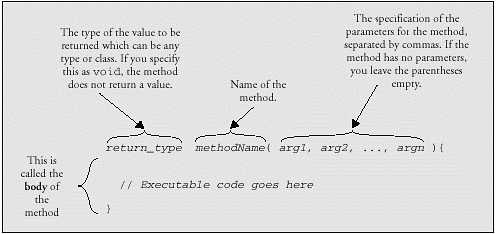WebReference.com - Part 1 of chapter 5 from Beginning Java 2 SDK 1.4 Edition, Wrox Press Ltd (5/8)
[previous] [next] |
Beginning Java 2 SDK 1.4 Edition
Defining Methods
We have been producing versions of the method main() since Chapter 1, so you already have
an idea of how a method is constructed. Nonetheless, we will go through from the beginning to make sure
everything is clear.
We'll start with the fundamental concepts. A method is a self-contained block of code that has a name, and has the property that it is reusable--the same method can be executed from as many different points in a program as you require. Methods also serve to break up large and complex calculations that might involve many lines of code into more manageable chunks. A method is executed by calling its name, as we will see, and the method may or may not return a value. Methods that do not return a value are called in a statement that just does the call. Methods that do return a value are usually called from within an expression, and the value that is returned by such a method is used in the evaluation of the expression.
The basic structure of a method is shown below.

When you specify the return type for a method, you are defining the type for the value that will
be returned by the method when you execute it. The method must always return a value of this type.
To define a method that does not return a value, you specify the return type as void.
Something called an access attribute can optionally precede the return type in a method
definition, but we will defer looking into this until later in this chapter.
The parameters to a method appear in its definition between parentheses following the method name. These specify what information is to be passed to the method when you execute it. Your methods do not have to have parameters specified. A method that does not require any information to be passed to it when it is executed has an empty pair of parentheses after the name.
Returning from a Method
To return a value from a method when its execution is complete you use a return statement, for example:
return return_value; // Return a value from a methodAfter executing the return statement, the program continues from the point where
the method was called. The value, return_value, that is returned by the method can be
any expression that produces a value of the type specified for the return value in the declaration
of the method. Methods that return a value--that is methods declared with a return type other than
void--must always finish by executing a return statement that returns a value of the
appropriate type. Note, though, that you can put several return statements within a
method if the logic requires this. If a method does not return a value, you can just use the
keyword return by itself to end execution of the method:
return; // Return from a methodNote that, for methods that do not return a value, falling through the closing brace enclosing
the body of the method is equivalent to executing a return statement.
[previous] [next] |
Created: June 24, 2002
Revised: June 24, 2002
URL: https://webreference.com/programming/java/beginning/chap5/1/5.html


 Find a programming school near you
Find a programming school near you